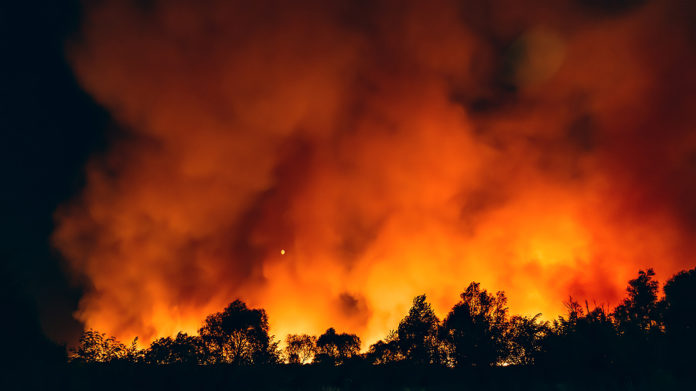
By Mike Zblewski, director of safety services for Sentry Insurance
The summer heat is here, and so are the wildfire risks that come with it.
Wildfires burn millions of acres across the United States each year—disrupting food processors. What’s more, regional wildfire data often overlaps with the industry’s highest areas of employment, exacerbating the situation.
In short, wildfires can occur anywhere, and your business needs to prepare now. With many states facing the highest drought season since 2013, I’ve gathered our Sentry safety team’s most important wildfire tips. While this list will help you get a head start, it doesn’t replace the conversations you should have with your local experts.
Let’s get started.
Prepare your facility
Your facility is the lifeblood of your operations. It houses your employees, equipment, and products. Your facility can also defend your assets during wildfire season.
Start by looking at the landscape surrounding your building. The following considerations can reduce the risks of a fire reaching your facility:
- Trim tree limbs 10 feet above the ground (also known as ladder fuels).
- Minimize vegetation and storing combustible materials within a 50-foot radius of your building. If your business is on a slope, clear a 200-foot area around your building.
- Keep lawns watered and mowed. If you’re water-conserving, keep debris at least 30 feet clear of your building.
- Consider landscaping. Large patios, driveways, parking lots, and brick walls can reduce the spread of fires.
- Remove tree branches that overhang within 10 feet of your building, roof, or chimney.
- Remove dead trees or bushes from your property. Trim trees to maintain a 15-foot clearance between tree crowns.
Once your surrounding property is ready, walk through your facility to gauge whether you have the necessary protections in place. Human error causes nearly 85% of fires, according to the National Park Service, so protecting your property will take a team effort:
- Store combustible materials, such as wooden pallets, away from your building.
- Keep roofs and gutters clear of leaves, tree limbs, pine needles, and other debris.
- Keep flammable and combustible liquids in approved metal containers. Place them away from other materials that may burn.
- Store trash in fire-resistant containers.
- Install and maintain smoke alarms and automatic fire sprinkler systems.
- Prohibit smoking or limit smoking to designated areas. Locate outside smoking areas in paved areas and provide containers for cigarette butt disposal.
- Maintain an adequate number of portable fire extinguishers. Train your employees on how to use them, particularly during summer.
Update your emergency response plan
As I mentioned earlier, this article doesn’t replace the conversations you should have with local experts. Coordinate your emergency plan with local first responders and community officials. Local groups can help you incorporate geographic considerations, notification alerts, and updated contact information.
Develop an emergency response plan that also includes the following wildfire considerations:
- Emergency supplies: Supplies should include flashlights, battery-powered TVs and radios, extra batteries, first aid kits, non-perishable food, and water.
- Firefighting tools: Useful tools include shovels, rakes, hoses, axes, saws, buckets for water, and ladders long enough to reach the roof.
Your team should feel informed and prepared enough to put the plan into action. Ongoing fire prevention training is a great way to keep employees feeling confident.
Follow the advice of local officials
Successful preparation starts with communication. Listen to media reports about wildfires in your area.
If anyone on your team spots a fire—no matter the size—contact your emergency response organizations. If local authorities order an evacuation, it’s time to follow your emergency response plan:
- Evacuate the building and surrounding area
- Verify that employees, visitors, and customers are out of the building
Wildfires spread fast, but if time permits, the following actions can help reduce damage to your facility:
- Use hoses or sprinklers to wet roofs, walls, and nearby vegetation
- Seal air-ventilation vents
- Turn off natural and propane gas sources
- Remove combustible and flammable materials from around all buildings
- Close all doors and windows
- Remove essential business records
- Move combustible materials such as wooden supplies toward the center of your building
Returning to your business
If your business pauses operations, don’t return to your facility until local authorities say it’s safe to do so. Once you return, monitor any hazardous areas your employees should avoid:
- Check your building for hot spots, embers, sparks, or other evidence of fire damage
- Contact local contractors to repair any damaged electrical, water, sprinkler, or structural systems
- Stay clear of downed electrical lines
- Check your building for any water damage
- Re-test water supplies before reusing them
Weather-related disasters are complex and inevitable; however, it is possible to reduce your risk. Stay vigilant and update your emergency response plan to add certainty to an uncertain season. Your commitment now is the key to protecting your business and employees later. Stay safe this summer.
 Mike Zblewski is the director of safety services for Sentry Insurance. Sentry provides insurance and safety services to food processing businesses. For more information, visit sentry.com.
Mike Zblewski is the director of safety services for Sentry Insurance. Sentry provides insurance and safety services to food processing businesses. For more information, visit sentry.com.







![[eBook] The Quality Imperative for Food And Beverage Manufacturers](https://foodindustryexecutive.com/wp-content/uploads/2024/09/th-The-quality-imperative-for-food-n-beverage-manufacturers-eBook-English-457px-1-218x150.jpg)


